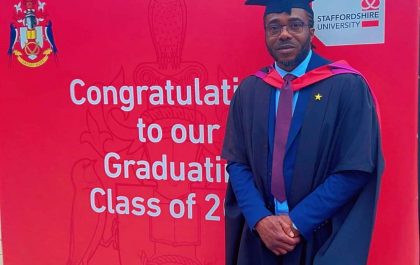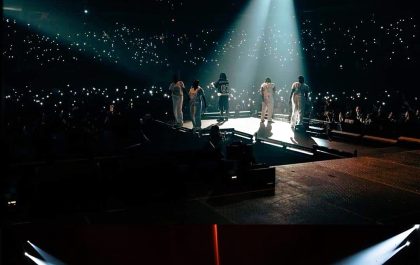–University of California – Santa Barbara
Information technology continues to progress at a rapid pace. However, the growing demands of data centers have pushed electrical input-output systems to their physical limit, which has created a bottleneck. Maintaining this growth will require a shift in how we built computers.
Information technology continues to progress at a rapid pace. However, the growing demands of data centers have pushed electrical input-output systems to their physical limit, which has created a bottleneck. Maintaining this growth will require a shift in how we built computers.
Over the last decade, photonics has provided a solution to the chip-to-chip bandwidth problem in the electronic world by increasing the link distance between servers with higher bandwidth, far less energy and lower latency compared to electrical interconnects.
One element of this revolution, silicon photonics, was advanced 15 years ago by the demonstration from UC Santa Barbara and Intel of a silicon laser technology. This has since triggered an explosion of this field. Intel is now delivering millions of silicon photonic transceivers for data centers all around the world.
A new discovery in silicon photonics by a collaboration of UC Santa Barbara, Caltech and the Swiss Federal Institute of Technology Lausanne (EPFL) reveals another revolution in this field. The group managed to simplify and condense a complex optical system onto a single silicon photonic chip. The achievement, featured in Nature, significantly lowers the cost of production and allows for easy integration with traditional, silicon chip production.
“The entire internet is driven by photonics now,” said John Bowers, who holds the Fred Kavli Chair in Nanotechnology at UC Santa Barbara, directs the campus’s Institute for Energy Efficiency and led the collaborative research effort.
Despite the great success of photonics in the Internet backbone, challenges still exist. The explosion of data traffic puts a growing requirement on the data rate each individual silicon photonic chip can handle. Using multicolor laser light to transmit information is the most efficient way to address this demand. The more laser colors, the more information that can be carried.
However, this poses a problem for integrated lasers, which can generate only one color of laser light at a time. “You might literally need 50 or more lasers in that chip for that purpose” said Bowers. And using 50 lasers has a number of drawbacks. It’s expensive, and rather inefficient in terms of power. What’s more, the frequency of light each laser produces can fluctuate slightly due to noise and heat. With multiple lasers, the frequencies can even drift into each other, much like early radio stations did.
A technology called “optical frequency combs” provide a promising solution to address this problem. It refers to a collection of equally spaced frequencies of laser light. Plotting the frequencies reveals spikes and dips that resemble a hair comb — hence the name. However, generating combs required bulky, expensive equipment. Using an integrated photonics approach, Bowers’ team has demonstrated the smallest comb generator in the world, which resolves all of these problems.
The configuration of the system is rather simple, consisting of a commercially distributed feedback laser and a silicon nitride photonic chip. “What we have is a source that generates all these colors out of one laser and one chip. That’s what’s significant about this,” Bowers said.
The simple structure leads to a significant reduction of scale, power and cost. The whole setup now fits in a package smaller than a match box, whose overall price and power consumption are smaller than previous systems.
What’s more, the new technology is also much more convenient to operate. Previously, generating a stable comb had been a tricky endeavor. Researchers had to modulate the frequency and adjust power just right to produce a coherent comb state, called soliton. That process was not guaranteed to generate such state every time. “The new approach makes the process as easy as switching on a room light,” said coauthor Kerry Vahala, a professor of applied physics and information science and technology at Caltech.
“What is remarkable about the result is the reproducibility with which frequency combs can be generated on demand,” added Tobias J. Kippenberg, professor of physics at EPFL who provided the low loss silicon nitride photonics chips, a technology already commercialized via LIGENTEC. “This process used to require elaborate control in the past.”
The magic behind all these improvements lies in an interesting physical phenomenon. When the pump laser and resonator are integrated, the interaction between them forms a highly coupled system that is self-injection locking and simultaneously generates “solitons,” pulses that circulate indefinitely inside the resonator and give rise to optical frequency combs. “Such interaction is the key to directly generating the comb and operating it in the soliton state” explained coauthor Lin Chang, a postdoctoral researcher in Bowers’ lab.
This new technology will have a big impact on photonics. In addition to addressing the demands of multicolor light sources in communication related products, it also opens up a lot of new opportunities in many applications. One example is optical clocks, which provide the most accurate time standard in the world and have many uses — from navigation in daily life to measurements of physical constants.
“Optical clocks used to be large, heavy and expensive,” Bowers noted, “and there are only a few in the world. With integrated photonics, we can make something that could fit in a wristwatch, and you could afford it. Low noise integrated optical microcombs will enable a new generation of optical clocks, communications and sensors. We should see more compact, more sensitive GPS receivers coming out of this approach.”
All in all, the future looks bright for photonics. “It is the key step to transfer the frequency comb technology from the laboratory to the real world.” Bowers said. “It will change photonics and our daily lives.”
Related posts
Global | Didi Angaye Earns A Distinction Award, Another Feather To The Cap
On a bright sunny day, in the month of July, 2024, the prestigious Staffordshire University located in the West Midlands of England organised its Award giving and Graduation ceremony to honour graduates of various educational programmes and courses which it offers. Didi Timipah Angaye,…
Olu Of Warri Bags Award In UK, Wife Advocates Return To Cultural Values
The Olu of Warri, Ogiame Atuwatse III, has received the Leadership and Community Development award at the 14th African Achievers Awards (AAA), which took place at the Parliament House, United Kingdom. The award was presented by a member of the House of Lords, London, Rt…
Brit Awards | Asake, Burna Boy And Other ‘New Cats’ Get Nominations
Nigerian singers Burna Boy, Asake, and Rema have been nominated for the 2024 Brit Awards. The nomination list for the annual music awards show was released on Wednesday 25, January 2024. Burna Boy and Asake made the ‘Best International Artiste’ category, while ‘Calm…
Brit Awards 2024 | The Full List Of Artist(e)s
This year’s Brits nominees have been revealed ahead of the ceremony in London in March. Dua Lipa is the first star confirmed to perform at the event – but how many awards is she up for? Musicians including Raye, Central Cee, J Hus and Blur are also…
Despite Increased Transfer Volume And Institutional Adoption, Bitcoin Stays Below $60K
Bitcoin’s price hovers around $59K as increased transfer volume indicates a stable demand among investors. CryptoQuant data indicates buyers are absorbing the panic selling pressure around the $57K price level. Bitwise’s latest report suggests that institutional investors are still buying Bitcoin despite the recent price…
Traders Focus On Meme Coins As Bitcoin, Ethereum And XRP Erase Recent Gains
Bitcoin, Ethereum and XRP dip under key support levels at $60,000, $2,600 and $0.60 respectively. Tron ecosystem’s meme launchpad SunPump generates over $1.1 million in revenue within twelve days of its launch. Tron network daily revenue reached a record high of $26.83 million on Tuesday,…
Top 10 Cryptocurrencies To Invest in January 2024
-Michael Adams From Bitcoin and Ethereum to Dogecoin and Tether, there are thousands of different cryptocurrencies, making it overwhelming when you’re first getting started in the world of crypto. To help you get your bearings, these are the top 10 cryptocurrencies based on their market…
The Risk And Reward Of ChatGPT In Cybersecurity
Juan is an experienced CTO with a demonstrated history of working in the computer and network security industry. He is an information technology professional skilled in SAP and Oracle applications, computer forensics, vulnerabilities research, IPS/IDS and information security. Unless you’ve been on a retreat in…











